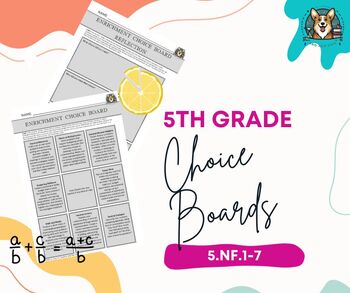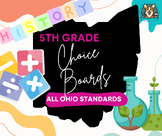5th Grade Number and Operations Fractions Choice Boards 5.NF.1-7
Just A Teacher And Her Dog
3 Followers
Grade Levels
5th
Subjects
Resource Type
Standards
CCSS5.NF.A.1
CCSS5.NF.A.2
CCSS5.NF.B.3
CCSS5.NF.B.4
CCSS5.NF.B.4a
Formats Included
- Zip
Pages
21 pages
Just A Teacher And Her Dog
3 Followers
Products in this Bundle (7)
showing 1-5 of 7 products
Also included in
- Prepare gifted learners for mathematical excellence with our comprehensive bundle encompassing choice boards tailored to every 5th-grade math standard. This exclusive collection is meticulously designed to challenge and engage advanced students, offering a diverse array of activities that promote hiPrice $15.00Original Price $23.00Save $8.00
- Embark on an enriching interdisciplinary journey through 5th-grade math, science, and social studies with our comprehensive Bundle of Choice Boards. Crafted to engage and empower students, this bundle offers a diverse selection of choice boards covering all standards across these core subjects, provPrice $33.60Original Price $48.00Save $14.40
Description
Unlock the full potential of gifted students in mastering fractions with our comprehensive set of Choice Boards aligned with standards 5.NF.1 through 5.NF.7. This meticulously designed resource empowers students to explore, engage, and excel in various facets of fraction concepts through differentiated and challenging activities.
Key Features:
- Multi-Standard Coverage: Our Choice Boards cover a wide spectrum of fraction standards (5.NF.1 - 5.NF.7), addressing fundamental concepts such as adding, subtracting, multiplying, and dividing fractions, interpreting division involving unit fractions and whole numbers, and applying these operations in real-world scenarios.
- Differentiated Tasks: Tailored for gifted learners, the boards offer tasks of varying complexity within each standard. Students choose activities according to their proficiency level, allowing them to progress at their own pace while experiencing appropriate levels of challenge.
- Visual Representation and Manipulation: Tasks include creating visual models, diagrams, and manipulatives to illustrate fraction concepts, aiding in a deeper understanding of fraction operations. Activities encourage students to visualize fractions in real-world contexts, enhancing comprehension.
- Real-World Problem-Solving: Engage in practical applications of fraction operations through problem-solving tasks rooted in real-life scenarios. Students tackle challenges involving measurements, sharing quantities, and practical mathematical applications, fostering critical thinking and application skills.
- Analytical and Creative Challenges: Encourage critical thinking and creativity through activities involving problem creation, comparative analysis of strategies, error identification, scenario expansion, and reflective journaling. These challenges deepen understanding and encourage higher-order thinking.
Benefits:
- Fosters a comprehensive understanding of fraction operations.
- Encourages critical thinking, problem-solving, and real-world application of fractions.
- Provides a flexible learning tool adaptable to individual learning styles and paces.
- Empowers gifted students to excel and explore fraction concepts at advanced levels.
Our Comprehensive Fraction Mastery Choice Boards cater to the needs of gifted students, offering a diverse range of tasks, challenges, and activities to elevate their understanding and proficiency in fractions across multiple standards.
Total Pages
21 pages
Answer Key
N/A
Teaching Duration
N/A
Report this resource to TPT
Reported resources will be reviewed by our team. Report this resource to let us know if this resource violates TPT’s content guidelines.
Standards
to see state-specific standards (only available in the US).
CCSS5.NF.A.1
Add and subtract fractions with unlike denominators (including mixed numbers) by replacing given fractions with equivalent fractions in such a way as to produce an equivalent sum or difference of fractions with like denominators. For example, 2/3 + 5/4 = 8/12 + 15/12 = 23/12. (In general, 𝘢/𝘣 + 𝘤/𝘥 = (𝘢𝘥 + 𝘣𝘤)/𝘣𝘥.)
CCSS5.NF.A.2
Solve word problems involving addition and subtraction of fractions referring to the same whole, including cases of unlike denominators, e.g., by using visual fraction models or equations to represent the problem. Use benchmark fractions and number sense of fractions to estimate mentally and assess the reasonableness of answers. For example, recognize an incorrect result 2/5 + 1/2 = 3/7, by observing that 3/7 < 1/2.
CCSS5.NF.B.3
Interpret a fraction as division of the numerator by the denominator (𝘢/𝘣 = 𝘢 ÷ 𝘣). Solve word problems involving division of whole numbers leading to answers in the form of fractions or mixed numbers, e.g., by using visual fraction models or equations to represent the problem. For example, interpret 3/4 as the result of dividing 3 by 4, noting that 3/4 multiplied by 4 equals 3, and that when 3 wholes are shared equally among 4 people each person has a share of size 3/4. If 9 people want to share a 50-pound sack of rice equally by weight, how many pounds of rice should each person get? Between what two whole numbers does your answer lie?
CCSS5.NF.B.4
Apply and extend previous understandings of multiplication to multiply a fraction or whole number by a fraction.
CCSS5.NF.B.4a
Interpret the product (𝘢/𝘣) × 𝘲 as a parts of a partition of 𝘲 into 𝘣 equal parts; equivalently, as the result of a sequence of operations 𝘢 × 𝘲 ÷ 𝘣. For example, use a visual fraction model to show (2/3) × 4 = 8/3, and create a story context for this equation. Do the same with (2/3) × (4/5) = 8/15. (In general, (𝘢/𝘣) × (𝘤/𝘥) = 𝘢𝘤/𝘣𝘥.)




